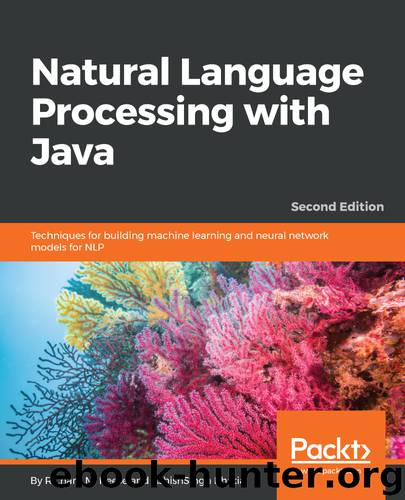Natural Language Processing with Java by Richard M. Reese

Author:Richard M. Reese
Language: eng
Format: epub
Tags: COM051280 - COMPUTERS / Programming Languages / Java, COM042000 - COMPUTERS / Natural Language Processing, COM044000 - COMPUTERS / Neural Networks
Publisher: Packt Publishing
Published: 2018-07-31T06:08:23+00:00
A maximum entropy tagger uses statistics to determine the POS for a word and often uses a corpus to train a model. A corpus is a collection of words marked up with POS tags. Corpora exist for a number of languages. These take a lot of effort to develop. Frequently used corpora include the Penn Treebank (https://www.seas.upenn.edu/~pdtb//) or Brown Corpus (http://www.essex.ac.uk/linguistics/external/clmt/w3c/corpus_ling/content/corpora/list/private/brown/brown.html).
A sample from the Penn Treebank corpus, which illustrates POS markup, is as follows:
Well/UH what/WP do/VBP you/PRP think/VB about/IN the/DT idea/NN of/IN ,/, uh/UH ,/, kids/NNS having/VBG to/TO do/VB public/JJ service/NN work/NN for/IN a/DT year/NN ?/.
There are traditionally nine parts of speech in English: nouns, verbs, articles, adjectives, prepositions, pronouns, adverbs, conjunctions, and interjections. However, a more complete analysis often requires additional categories and subcategories. There have been as many as 150 different parts of speech identified. In some situations, it may be necessary to create new tags. A short list is shown in the following table. These are the tags we will be using frequently in this chapter:
Part
Meaning
Download
This site does not store any files on its server. We only index and link to content provided by other sites. Please contact the content providers to delete copyright contents if any and email us, we'll remove relevant links or contents immediately.
The Mikado Method by Ola Ellnestam Daniel Brolund(20604)
Hello! Python by Anthony Briggs(19900)
Secrets of the JavaScript Ninja by John Resig Bear Bibeault(18208)
Dependency Injection in .NET by Mark Seemann(18109)
The Well-Grounded Java Developer by Benjamin J. Evans Martijn Verburg(17576)
OCA Java SE 8 Programmer I Certification Guide by Mala Gupta(17422)
Kotlin in Action by Dmitry Jemerov(17185)
Adobe Camera Raw For Digital Photographers Only by Rob Sheppard(16934)
Algorithms of the Intelligent Web by Haralambos Marmanis;Dmitry Babenko(16236)
Grails in Action by Glen Smith Peter Ledbrook(15390)
Test-Driven iOS Development with Swift 4 by Dominik Hauser(10393)
Becoming a Dynamics 365 Finance and Supply Chain Solution Architect by Brent Dawson(8056)
Microservices with Go by Alexander Shuiskov(7820)
Practical Design Patterns for Java Developers by Miroslav Wengner(7719)
Test Automation Engineering Handbook by Manikandan Sambamurthy(7672)
Angular Projects - Third Edition by Aristeidis Bampakos(7160)
The Art of Crafting User Stories by The Art of Crafting User Stories(6611)
NetSuite for Consultants - Second Edition by Peter Ries(6533)
Demystifying Cryptography with OpenSSL 3.0 by Alexei Khlebnikov(6305)
